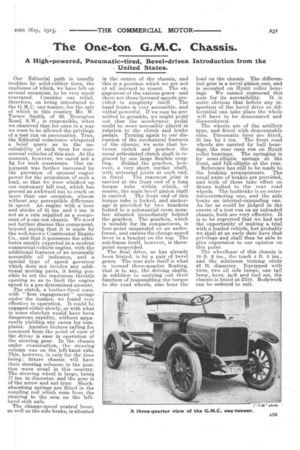The One-ton G.M.C. Chassis.
Page 7

If you've noticed an error in this article please click here to report it so we can fix it.
A High-powered, Pneumatic-tired, Bevel-driven Introduction from the United States.
Our Editorial . path is usually trodden by solid-rubber tires, the resilience of which, we have felt on several occasions, to be very much overrated. Consider our relief, therefore, on being introduced to the (1-.M.C, one-tonner, for the sale of which in this country Mr. W. Turner Smith, of 22, Brompton Road, S.W., is responsible, when we observed that for once in a way we were to be allowed the privilege of a test run on pneumatics. True, the Editorial conscience whispered a brief query as to the unsuitability of such tires for commercial vehicles of this size. At the moment, however, we cared not a fig for such conscience. Our enjoyment was further increased by the provision of unusual engine power for the propulsion of such a load, so that we were whisked up our customary hill test, which has proved an awkward nut to crack on more than one occasion, almost without any perceptible difference in speed. An engine with a bore and stroke of 34 ins. and 5 ins, is not as a rule supplied as a component of a one-ton chassis. We need not further discuss this component, beyond saying that it is made by the well-known Continental Engine Co., and that it possesses the attributes usually expected in a modern commercial-vehicle engine, with the additional features of an unusually accessible oil indicator, and a special type of speed governor which does not involve any additional moving parts, it being possible to set the maximum throttle Opening so as to limit the engine speed to a pre-determined amount.
The clutch, a leather-lined cone, with " first engagement" springs under the leather, we found very effective in operation. It could be engaged either slowly, or with what in some clutches would. have been dangerous rapidity, without apparently yielding any cause for complaint. Another feature calling for comment from the point of view of the driver is ease in operation of the steering gear. In the chassis under examination, the steering column was on the left-hand side. This, however, is only for the time being ; future chassis will have their steering columns in the position more usual in this country. The steering wheel is large, being 17 ins, in diameter, and the gear is of the screw and nut type. Shriekabsorbing springs are fitted in the coupling rod which runs from the steering to the arm on the lefthand stub axle.
The change-speed control lever, as well as the side brake, is-situa.ted in the centre of the chassis., and this is a position which we are not at all inclined to resent. The engagement of the various gears—and there are three forward speeds provided—is simplicity itself. The hand brake is very accessible, and withal powerful. If we may be permitted to grumble, we might point out that the accelerator pedal could be more accessibly placed in relation to the clutch and brake pedals. Turning again to our discussion of the mechanical features of the chassis, we note that between clutch and gearbox the usual articulated clutch shaft is replaced by one large flexible coupling. Behind the gearbox, however, a very short cardan shaft, with universal joints at each end,
is fitted. The rearmost joint is carried at the front end of a long torque tube within which,. of course, the main bevel pinion shaft is carried. The front end of this torque tube is forked, and anchorage is provided by two brackets bolted to a substantial cross member situated immediately behind the gearbox. The gearbox, which is notable for its compactness, is four-point suspended on an underframe, and carries the change-speed lever in a bracket on the top. The sub-frame itself, however, is threepoint suspended. The final drive, as has already been hinted, is by a pair of bevel gears. The rear axle itself is what is termed three-quarter floating, that is to say, the driving shafts, in addition to carrying out their function of transmitting the torque to the road wheels, also bear the load on the chassis. The differential gear is a bevel-pinion one, and is mounted on Hyatt roller bearings. We cannot commend this axle for its accessibility. It is quite obvious that before any inspection of the bevel drive or differential can take place the whole will have to be dismounted and dismembered.
The wheels are of the artilleiy type, and fitted with demountable rims. Pneumatic tires are fitted, 35 ins. by 5 ins. The front road wheels are carried by ball bearings, the rear ones run on Hyatt roller bearings. The springing is by semi-elliptic springs at the front, and full-elliptic at the rear.
Reference has still to be made to the braking arrangements. The usual pairs of brakes are provided, and both of these take effect on drums bolted to the rear road wheels. The footbrake is an external-contracting one, and the lekle brake an internal-expanding one. As far as could be judged in the course of a test run on an unloaded chassis, both are very effective. It is to be regretted that we had ribt the opportunity of making a trial with a loaded vehicle, but probably we shall at an early date have that privilege and shall then be able to give expression to our opinion on this point.
The wheelbase of this chassis is 10 ft. 2 ins., the track 4 ft. 8 ins., and the minimum turning circle 46 ft. diameter. Equipped with tires, two oil side lamps, one tail lamp, horn, jack and tool set, the chassis is listed at £310. Bodywork can be ordered to suit.






















